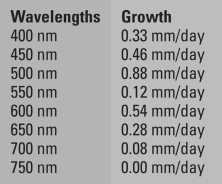Multiple Choice
Please use the following information to answer the following question(s) .
You work for a company selling tropical rain forest plants commonly found in the understory of the forest. These plants are shade tolerant and can be grown indoors because they require low light. Your employer wants you to find out what is the best type of light to maximize growth of these understory plants. Using a full spectrum of natural light would cause these plants to die because they are a shade-tolerant plant species.
From your biology class, you recall that the light-dependent reactions of photosynthesis involve pigment molecules that absorb light of specific wavelengths. You also remember the experiments done by the German biologist Theodor Engelmann, in which he separated light using a prism into different wavelengths and then determined which wavelengths were best for promoting photosynthesis in the algae species he was examining. Your goal is to determine which wavelengths (colors) of light are best for promoting photosynthesis to enhance growth in your species of plant. To achieve this, you grew your plants under different wavelengths of light and measured their growth rates. The wavelengths were measured in nanometers (nm) , and the growth rate was measured in millimeters per day (mm/day) . The data you collected are as follows:

Make a bar graph plotting growth rates on the y-axis and wavelengths of light on the x-axis. Referring to your graph, answer the following question(s) :
-Of the following,which wavelength is least useful to your plants?
A) 650 nm
B) 450 nm
C) 550 nm
D) 400 nm
Correct Answer:

Verified
Correct Answer:
Verified
Q2: In photosynthesis, an H<sup>+</sup> ion gradient forms
Q11: Please refer to the following art to
Q19: _ is the source of the oxygen
Q22: Which of the following is found in
Q27: What is one reason why plants have
Q34: The color that we see when looking
Q37: What name is given to the membranous
Q38: Where are photosystems located?<br>A) chlorophyll<br>B) thylakoid membrane<br>C)
Q39: The products of the light reactions of
Q41: What compound is found at the reaction